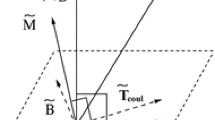Abstract
This paper investigates the orbit radial stabilization of a two-craft virtual Coulomb structure about circular orbits and at Earth–Moon libration points. A generic Lyapunov feedback controller is designed for asymptotically stabilizing an orbit radial configuration about circular orbits and collinear libration points. The new feedback controller at the libration points is provided as a generic control law in which circular Earth orbit control form a special case. This control law can withstand differential solar perturbation effects on the two-craft formation. Electrostatic Coulomb forces acting in the longitudinal direction control the relative distance between the two satellites and inertial electric propulsion thrusting acting in the transverse directions control the in-plane and out-of-plane attitude motions. The electrostatic virtual tether between the two craft is capable of both tensile and compressive forces. Using the Lyapunov’s second method the feedback control law guarantees closed loop stability. Numerical simulations using the non-linear control law are presented for circular orbits and at an Earth–Moon collinear libration point.
Similar content being viewed by others
References
Berryman, J., Schaub, H.: Static equilibrium configurations in GEO Coulomb spacecraft formations. In: Proceedings of the AAS/AIAA Space Flight Mechanics Meeting, paper no. 05-104, Copper Mountain, CO, USA, 23–27 Jan 2005
Berryman J., Schaub H.: Analytical charge analysis for 2- and 3-craft Coulomb formations. AIAA J. Guid. Control Dyn. 30(6), 1701–1710 (2007)
Fujii H.A., Uchiyama K., Kokubun K.: Mission function control of tethered subsatellite deployment/retrieval: in-plane and out-of-plane motion. J. Guid. Control Dyn. 14, 471–473 (1991)
Hastings D., Garrett H.: Spacecraft-Environment Interactions. Cambridge University Press, Cambridge, MA (2004)
Inampudi, R., Schaub, H.: Two-craft Coulomb formation relative equilibria about circular orbits and libration points. In: Proceedings of the AAS/AIAA Space Flight Mechanics Meeting, AAS paper no. 10-163, San Diego, CA, USA, 15–17 Feb 2010a
Inampudi, R., Schaub, H.: Orbit radial dynamic analysis of two-craft Coulomb formation at libration points. In: Proceedings of the AAS/AIAA Astrodynamics Specialist Conference, paper no. AIAA-2010-7965, Toronto, Canada, 2–5 Aug 2010b
King, L.B., Parker, G.G., Deshmukh, S., Chong J.-H.: Spacecraft formation-flying using inter-vehicle Coulomb forces. Technical report, NASA/NIAC, Jan 2002. http://www.niac.usra.edu
King L.B., Parker G.G., Deshmukh S., Chong J.-H.: Study of interspacecraft Coulomb forces and implications for formation flying. AIAA J. Propuls. Power 19(3), 497–505 (2003)
Lawrence D.A., Whorton M.S.: Solar sail dynamics and coning control in circular orbits. J. Guid. Control Dyn. 32(3), 974–985 (2009)
Li, H.: Application of solar radiation pressure to formation control near libration points. Ph.D. Dissertation, Department of Aerospace Engineering and Mechanical Engineering, University of Cincinnati, OH, USA, Feb 2008
McInnes C.R.: Solar Sailing: Technology, Dynamics and Mission Applications. Springer-Praxis, Chichester (1999)
Meirovitch L.: Methods of Analytical Dynamics. Dover Publications, Inc., Mineola, NY (2003)
Misra, A.K., Bellerose, J., Modi, V.J.: Dynamics of a tethered system near the Earth–Moon Lagrangian points. In: Proceedings of the 2001 AAS/AIAA Astrodynamics Specialist Conference, vol. 109 of Advances in the Astronautical Sciences, pp. 415–435, Quebec City, Canada (2002)
Murdoch, N., Izzo, D., Bombardelli, C., Carnelli, I., Hilgers, A., Rodgers, D.: The electrostatic tractor for asteroid deflection. In: 58th International Astronautical Congress, 2008, paper IAC-08-A3.I.5
Natarajan, A.: A study of dynamics and stability of two-craft Coulomb tether formations. Ph.D. dissertation, Aerospace and Ocean Engineering Department, Virginia Polytechnic Institute and State University, Blacksburg, VA, USA, May 2007
Pettazzi, L., Krüger, H., Theil, S., Izzo, D.: Electrostatic forces for satellite swarm navigation and reconfiguration. Technical report, ESA, Doc. no.: ARI-SS-FP-ZAR-001 (2006)
Romanelli, C.C., Natarajan, A., Schaub, H., Parker, G.G., King, L.B.: Coulomb spacecraft voltage study due to differential orbital perturbations. In: Proceedings of the AAS/AIAA Space Flight Mechanics Meeting, Tampa, FL, USA, paper no. AAS 06-123, 22–26 Jan 2006
Schaub H., Junkins J.L.: Analytical Mechanics of Space Systems. AIAA Education Series, Reston, VA (2003)
Schaub H., Hall C.D., Berryman J.: Necessary conditions for circularly-restricted static Coulomb formations. AAS J. Astronaut. Sci. 54(3–4), 525–541 (2006)
Vadali S.R., Kim E.S. (1991) Feedback control of tethered satellites using Lyapunov stability theory. J. Guid. Control Dyn. 14:729–735
Vasavada H., Schaub H.: Analytic solutions for equal mass 4-craft static Coulomb formation. J. Astronaut. Sci. 56(1), 7–40 (2008)
Author information
Authors and Affiliations
Corresponding author
Rights and permissions
About this article
Cite this article
Inampudi, R., Schaub, H. Disturbance compensating control of orbit radially aligned two-craft Coulomb formation. Celest Mech Dyn Astr 112, 445–458 (2012). https://doi.org/10.1007/s10569-012-9403-5
Received:
Accepted:
Published:
Issue Date:
DOI: https://doi.org/10.1007/s10569-012-9403-5




